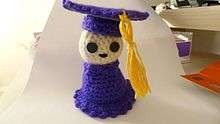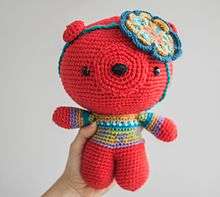Amigurumi


Amigurumi (編みぐるみ, lit. crocheted or knitted stuffed toy) Amigurumi is the Japanese art of knitting or crocheting small, stuffed creatures. The word is a portmanteau of the Japanese words ami, meaning crocheted or knitted, and nuigurumi, meaning stuffed doll.[1] In the west are called Amigurumi, which are the original phonetics of 編みぐるみ in Japanese language.[2] An Amigurumi has the attributes that the designer desires to put into it and the medium is yarn. Amigurumis vary in size and there are no restrictions about size or look.[3] While Amigurumi has been known in Japan for several decades, Amigurumi first started appealing to the masses in other countries, especially in the West, in 2003.[4] By 2006, amigurumi were reported to be some of the most popular items on Etsy, an online craft marketplace, where they typically sold for $10 to $100.[4] Since then popularity has continued to increase.[5]

Even though Amigurumis seem popular online due to their presence in sites such as Etsy, Pinterest and Ravelry, Amigurumi is still a developing craft permeated and directly depending of emerging trends and popular culture.[6]
Origins
According to the Crochet Guild of America there are earlier records of crocheted or knitted dolls made In China, early examples were known of three-dimensional dolls worked in crochet.[7]
As background knowledge in the search of the origins of Amigurumi, Yoshihiro Matushita states that since the year 1185 there exists records of analogous techniques in Japan, such as Needle Binding. It is a fabric creation technique predating knitting and crocheting. During the ‘Edo’ period (1603-1867) Japan traded with the Dutch and as a result it is believed that knitting was introduced as a technique.
Furthermore the evolution of knitting were made by the Samurais, who were experts in creating garments and decorations for their katanas and winterwear. The author speculates that knitting might also have been learned by sex workers in the Japanese brothels. (Kihara, 2002).
During the Meji era (1868-1912) Japan transitioned from being a feudal society into a more modern model. It was also during that period that the Industrialization started in the country. The educational model was changed and a new Western-based education system for young people was inaugurated. Thousands of students were sent abroad to learn practices from the west. More than 3,000 westerners were hired to teach modern science, mathematics, technology, and foreign languages in Japan. (Meyers, 2013)[8]
According to Dai Watanabe who made a quick survey in the origins of Amigurumi, “Women were invited to teach western needleworks during that time” . She also points out that the first stuffed crocheted motif as 西洋毛糸編物教授 (Seiyo-keito-amimono-kyouju, a Twigged loquat with a leaf and more fruit motifs starting appearing in 1920. (Watanabe, 2015).
Amigurumi as a term might have originated in Japan after WW II (1945) as an evolution of knitting and crocheting techniques. These techniques were brought by foreign visitors to Japan and might have been an alternative for families to create toys for their children during the huge economical crisis in the country.
Aesthetic
The most popular aesthetic of Amigurumi is cuteness or Kawaii. (Oversized spherical head on a cylindrical body with undersized extremities, usually termed a chibi style outside Japan). The actual fascination of western culture for cute and lovely things and the preference of Amigurumi Artists to strive towards these specific attributes such as being cute and small (chibi) might easily be a trend and not an unbreakable rule.[9] According to Miyuki Ichikawa and Tomoko Takamori, pioneers of the new wave of Amigurumi design, there is no rules in the aesthetics of Amigurumi, many people prefer the Kawaisa look because it is more appreciated visually by people.[9]
Amigurumi may be used as children's toys but are generally purchased or made solely for aesthetic purposes.[10] Although Amigurumi originated in Japan, the craft has become popular around the world.[11] It important to add that Amigurumis are characters that have a story and a personality. They are metaphors for the good and bad in any living spirit. For example, like many commercial toys have, Amigurumis should also have their own tastes, accessories and likes. We see examples of these personalities in commercial dolls such as Barbie or My Little Pony.[12]
Technique
Amigurumi can be knitted, though are usually crocheted out of yarn using the basic techniques of crochet (single crochet stitch (Sc), double crochet (db), Invisible decrease (inv.Dec) etc. . Amigurumi are usually worked one section at a time and then sewed or crocheted together, except for some Amigurumi which are worked as one piece. In crochet, Amigurumi is typically worked in spiral rounds, in order to prevent "striping," a typical feature of joining crochet rounds in a project.
Typically, crochet hooks or knitting needles that are slightly smaller than one would use in a typical project are used, in order to achieve a tight gauge that retains stuffing and does not allow the stuffing to show through the fabric.[13] Stuffing is usually standard polyester or cotton craft stuffing, but may be improvised from other materials.[13] Plastic pellets, glass pebbles and even stones may be inserted beneath stuffing in order to distribute weight at the bottom of the figure.[13]
Types of Amigurumi [14]
An Amigurumi is a product of the imagination or a representation of what is seen. It does not always have to look cute, have big head and a small body. An Amigurumi can look in
any way as long as it is crocheted or knitted, worked on the round and at least 80% made out of yarn (acrylic, cotton, wool, etc).
Amigurumi Art toys
The complexity of the design involves personalization, research and development in a more experimental and artistic way. Usually these toys are delicate, meant to be displayed and are not suitable for small children.
Amigurumi Soft toys
An Amigurumi soft toy is a toy made in fiber yarn which is minimum 80% crocheted. This crocheted toy has play value (Heljakka, 2013, 135)[15] for the adult or child that the toy is intended for.
References
- ↑ Williams, M.E. (August 7, 2007). "DIY Definitions: Amigurumi (with tutorial)".
- ↑ Ramirez Saldarriaga, Jennifer (2016). Amigurumi. Helsinki, Finland: The Sun and the Turtle. p. 5.
The word Amigurumi comes from Ami- meaning crocheted or knitted and Nuigurumi meaning stuffed doll. In the west we call them Amigurumi, which are the original phonetics of 編みぐる in Japanese language.
- ↑ Ramirez Saldarriaga, Jennifer (2016). Amigurumi. Helsinki, Finland: The Sun and the Turtle. p. 5.
Even though Amigurumis seem popular online due to their presence in sites such as Etsy, Pinterest and Ravelry, Amigurumi is still a developing craft permeated and directly depending of emerging trends and popular culture.
- 1 2 Mary Belton (2006). Craft, Volume 1: Transforming Traditional Crafts. O'Reilly Media. pp. 41–42. ISBN 978-0-596-52928-4. Retrieved 2010-03-20.
- ↑ "Google Trends: Amigurumi". December 22, 2013.
- ↑ Ramirez Saldarriaga, Jennifer (2016). Amigurumi. Helsinki, Finland: The Sun and the Turtle. p. 5.
Even though Amigurumis seem popular online due to their presence in sites such as Etsy, Pinterest and Ravelry, Amigurumi is still a developing craft permeated and directly depending of emerging trends and popular culture.
- ↑ Marks, Ruthie (1997). "dolls+and+china" "History of Crochet". http://www.crochet.org/?page=CrochetHistory&hhSearchTerms="dolls+and+china". Crochet Guild of America. Retrieved 2016-11-17. External link in
|website=(help) - ↑ Ramirez Saldarriaga, Jennifer (2016). Amigurumi. Helsinki, Finland: The Sun and the Turtle. pp. 9–12.
- 1 2 Ramirez Saldarriaga, Jennifer (2016). Amigurumi. Helsinki, Finland: The Sun and the Turtle. pp. 22–23.
- ↑ Mary Beth Temple (2009). Hooked for Life: Adventures of a Crochet Zealot. Andrews McMeel. pp. 40–41. ISBN 978-0-7407-7812-4. Retrieved 2010-03-20.
- ↑ Evelly, Jeanmarie (16 December 2014). "Thousands of Knitted and Crocheted 'Amigurumi' Fill LIC Gallery". DNAinfo. Retrieved 10 March 2015.
- ↑ Ramirez Saldarriaga, Jennifer (2016). Amigurumi. Helsinki, Finland: The Sun and the Turtle. p. 24.
- 1 2 3 Annie Obaachan (2008). Amigurumi Animals: 15 Patterns and Dozens of Techniques for Creating Cute Crochet Creatures. Macmillan. pp. 12–16. ISBN 978-0-312-37820-2. Retrieved 2010-03-20.
- ↑ Ramirez Saldarriaga, Jennifer (2016). Amigurumi. Helsinki, Finland: The Sun and the Turtle. pp. 25–27.
Excerpt of Types of Amigurumi Characters from Chapter "Aesthetics of amigurumi toys".
- ↑ Heljakka, Katriina (2013). Principles of adult play(fulness) in contemporary toy cultures. Helsinki, Finland: Aalto ARTS Books. p. 135. ISBN 978-952-60-5143-7.
External links
![]() Media related to Amigurumi at Wikimedia Commons
Media related to Amigurumi at Wikimedia Commons
